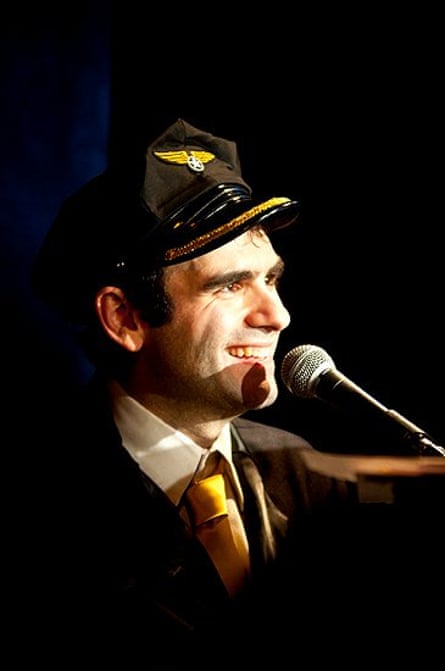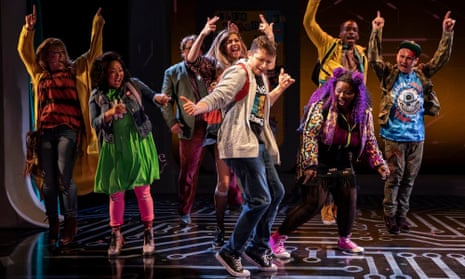When high school-set musical Be More Chill finished its month-long run at New Jersey’s Two River Theatre three summers ago, composer Joe Iconis was already familiar with the sinking disappointment of putting a show to bed. Many times before, he says, a musical of his had enjoyed a solid run off-off-Broadway, or at a regional theatre, and failed to gain traction after attempts to woo producers. “It’s not like, all of us crying together, singing show tunes, thinking about what might’ve been,” he tells the Guardian, reflecting on the letdown. “It’s messier and sadder than that. It’s everyone being bummed, thinking maybe something will happen but knowing nothing will. I’ve just gotten better at compartmentalizing it.”
Shortly after the show closed, Two River funded a cast album, which dropped quietly on streaming sites in 2015. As far as Iconis knew, that was that. But then, in early 2017, something strange happened.
Be More Chill – the bombastic pop-rock, sci-fi musical about an anxious teenager named Jeremy who takes a mysterious black market drug to get popular (quite literally, a chill pill) – experienced something of an e-renaissance, precipitated by the cast album recorded with little fanfare.
Book writer Joe Tracz began to receive messages on Instagram from fans whose social media avatars featured Jeremy’s vandalized knapsack or a photo of George Salazar, who plays the best friend and fellow outcast Michael. Teens who had never seen the show live made Tumblr pages and digizines. On forums they commiserated about their “Squips”, a reference to the computerized man the drug makes manifest in Jeremy’s head as a didact of chillness. It was the second most popular musical on Tumblr in 2017, right behind one called Hamilton. Inconceivably, from a little non-profit theater in Red Bank across the river, a veritable, impassioned online fandom had sprouted.
“I was like, maybe somewhere three people discovered this cast album,” recalls Tracz. “Then those three people became 30, which became 300, which became over 150m streams on Spotify.”
Fast forward to August 2018: Iconis, 36, effusive, and deeply literate in musical theatre, sits in the lounge area at the Signature Center, where Be More Chill’s off-Broadway engagement has been extended another week. Its original run sold out in hours, an unprecedented achievement for a show that idled in musical theatre limbo for two years. “Surreal” is how he describes the last several months. “I’m convinced it’s a dream and this entire phenomenon will dissipate if I’m awakened,” adds Tracz, his collaborator.
Adapted from Ned Vizzini’s 2004 novel, Be More Chill is a comic and vaguely fantastical take on the trope of the ne’er-do-well high schooler, drawing not-unjustified comparisons to Glee and Dear Evan Hansen. Its humor is dirty and mordant, its songs energetic and maximal. Beneath the surface, though, is a strand of heavy pathos. The standout number, in which Michael lingers in the bathroom at a house party to deliver an aria brimming with teenage neuroses, is devastatingly relatable. But it’s countered by ditties like The Telephone Hour – a humorous nod to Bye, Bye Birdie where landlines are replaced with iPhones – and songs that casually reference suicide and masturbation.
“People ask a lot if Michael in the Bathroom is a sad or a funny song,” says Tracz, who tells them it’s both. “When you’re alone in the bathroom at a party, it’s the most traumatic, visceral, raw experience. And then you survive that and you’re able to laugh, because you made it through what felt so huge at the time.”

It’s this emphasis on fleeting moments that, to a high schooler, seem downright cataclysmic, that has fueled the Be More Chill phenomenon. At a show in early August, throngs of giddy teens were in attendance, some with friends and some with parents. A wall outside the theatre is plastered in sticky-notes where they shared their own “Squips” – names included Rachel Bloom, Neil Patrick Harris and Ben Platt. Iconis, whose past musicals include The Black Suits and The Plant That Ate Dirty Socks, particularly enjoys writing teenage characters, whose emotional vulnerability lends itself to the cathartic conventions of musical theatre.
“I really stand by this idea that young people are people,” he says, responding to a question about the way critics often condescend to teenage content. “Teenage characters are going through the same things adults are, they just don’t have the vocabulary to express themselves, or they haven’t built up the walls adults do. There’s this idea in musical theater that you sing when your emotions are too big to do anything else but sing. For me, that’s the teenage experience. All these feelings, emotions, issues swirling around. It feels like musicals to me.”

Not long ago Iconis and Tracz were fanboys themselves, seeking solace and fellowship in the New York Times theatre listings or early-internet message boards. The former grew up in Long Island, making regular trips to Manhattan with his aunt to attend shows like Little Shop of Horrors, which he saw on his sixth birthday. In high school, he bootlegged the soundtrack to Hedwig and the Angry Inch, listening to it obsessively while working for the school magazine. Tracz, a self-described “huge fandom person” who grew up a “nerdy, geeky gay boy”, was himself a connoisseur of Harry Potter and Batman fan fiction.
“I’m the person I am because I found these fan communities that made me feel like the things I liked weren’t weird and the things I felt weren’t weird. To be able to give that back to the world has been the most gratifying thing,” he says. “It’s not just people listening to it by themselves in their bedrooms. They’re forging connections and community.”
The Be More Chill community is a product of what might be called fanbase cross-fertilization. Will Roland, who plays the lead Jeremy, originated the role of Jared in Dear Evan Hansen; Salazar starred in the off-Broadway adventure musical The Lightning Thief, for which Tracz wrote the book. Among the show’s fans, there’s a clear predilection for Salazar’s Michael, the stoner outcast who delivers the show’s musical climax. But the love is spread throughout: for Roland, the affably nervy protagonist; for Stephanie Hsu, who plays Christine, the theatre nerd who walks the halls with Barbra Streisand’s memoir in tow; for Gerard Canonico as the animated punk Rich Baranski; and for the “Squip” Jason Tam, the sentient computer who appears onstage in ever-more avant garde fashions.
Both Iconis and Tracz describe the possibility of a Broadway run as a “dream”, though neither is in the business of predicting what’s next for a show that’s already well past its presumed expiration date. What they can say, however, is that the Be More Chill phenomenon doesn’t exactly depend on a tour of the Great White Way. Their show, in a shock to the typical musical theatre business model, has confirmed the pull, power and profitability of teenagers armed with Tumblr pages and Spotify accounts. In other words, the sky is the limit.
“I love that a show like Be More Chill could exist alongside all sorts of shows, so Broadway is the dream of dreams,” says Iconis. “But if the show really does get bigger, I think a theme park is the next step. A log flume based on a show tune. I don’t think that’s happened before and I’d like to be the reason for that.”

Comments (…)
Sign in or create your Guardian account to join the discussion